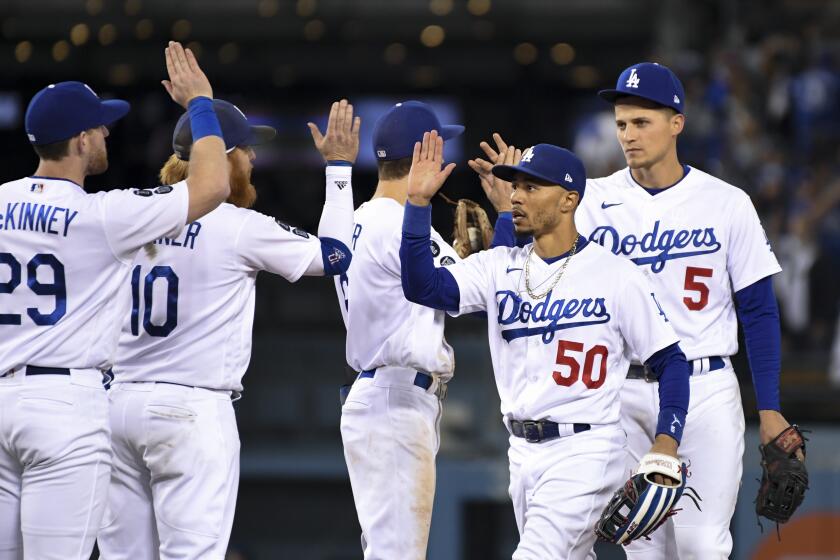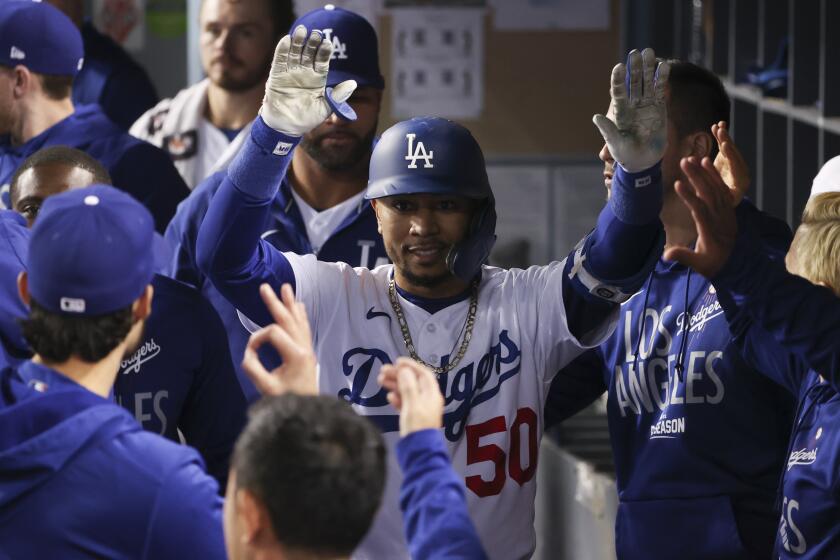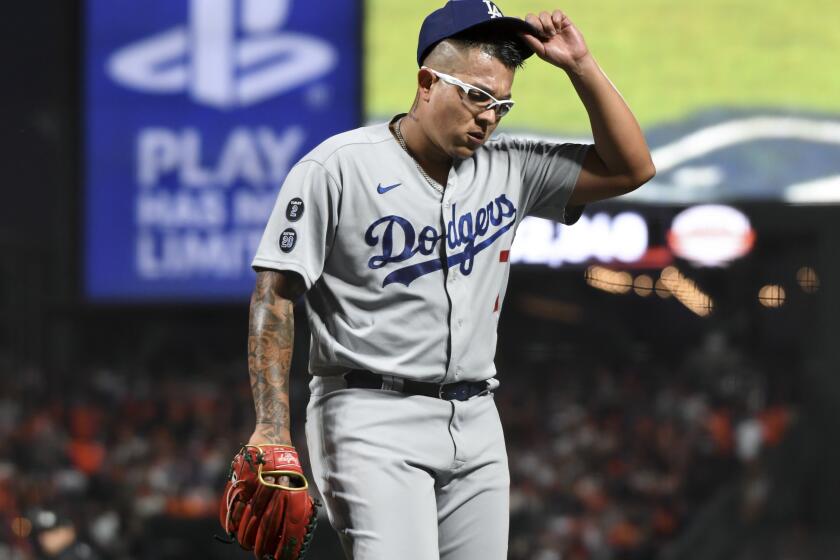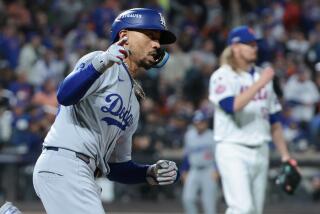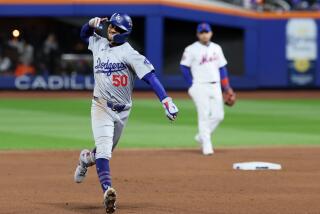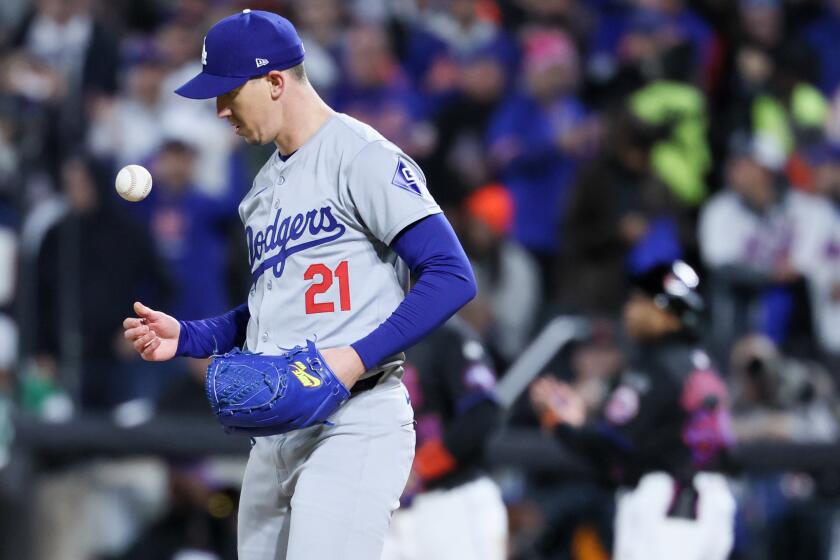Dodgers vs. Giants: Five takeaways from Game 4 of the NL Division Series
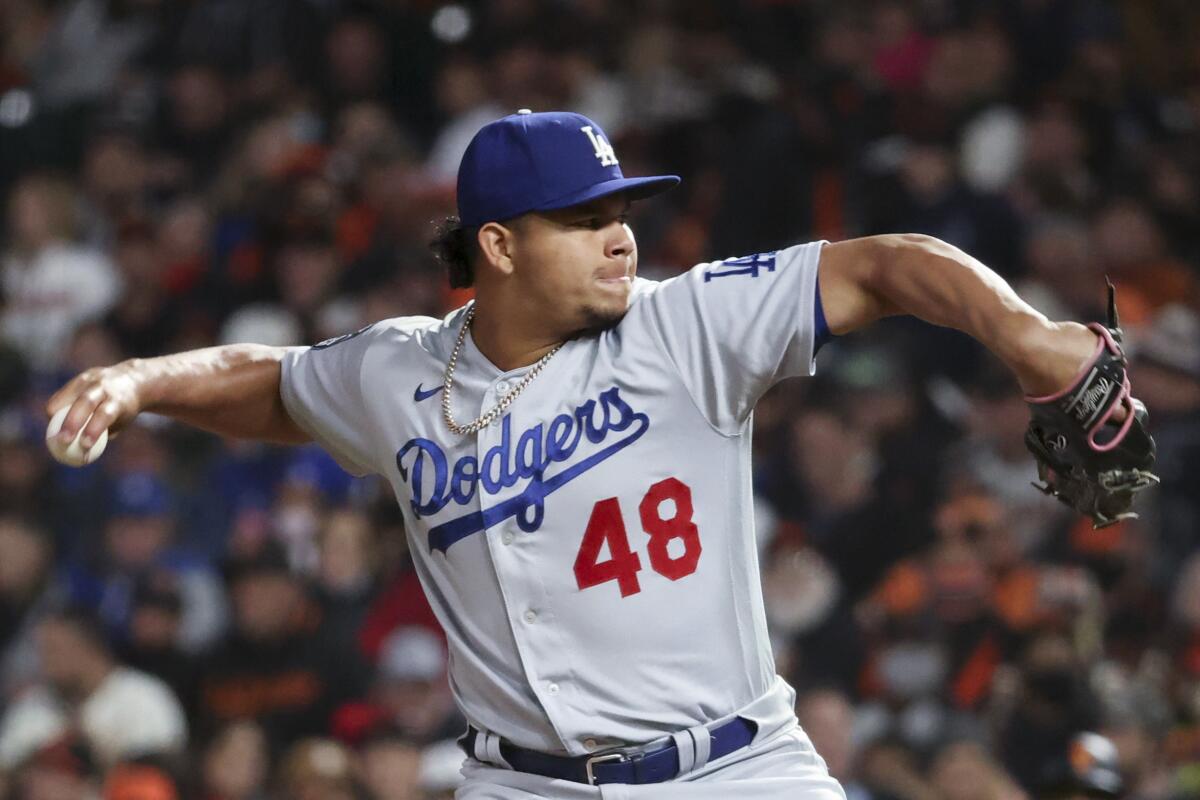
- Share via
The Dodgers did more than just stave off postseason elimination Tuesday night.
With a 7-2 win over the San Francisco Giants in Game 4 of the National League Division Series, they took back momentum against their in-state rivals in a victory keyed by big gambles, important adjustments and a sound game plan on the mound and at the plate.
Now, they’ll head back to San Francisco for a winner-take-all Game 5 on Thursday night.
Until then, here are five takeaways from the triumph that extended the Dodgers’ season at least one more game.
Big part of field, big-time success
Aggressiveness can take many forms at the plate.
Swinging too early in counts. Swinging at too many pitches outside the strike zone. Or swinging too soon at individual offerings.
The latter was something Dodgers manager Dave Roberts has emphasized throughout the series, saying he wanted to see his club use “the big part of the field” more often and wait a split second longer to swing to drive the ball up the middle or to the opposite field.
“It just allows us to see the baseball a little bit longer,” Roberts said. “Make better swing decisions.”
The Dodgers didn’t go quietly into the night in Game 4 of the NLDS against San Francisco. Instead, they showed determination in setting up a Game 5 showdown.
The Dodgers’ seven-run, 12-hit outburst in Game 4 backed up that approach.
Of the 30 balls the Dodgers put in play, 17 were hit either to center field or the other way. Eight of those were hits, including home runs by Mookie Betts and Will Smith. And the tone was set early, when Corey Seager and Trea Turner drove a single and double in back-to-back first-inning at-bats, respectively, to the opposite field to open the scoring.
“We talked after Game 1,” Roberts said. “I think when we’re at our best is when we use the big part of the field.”
Indeed, in the series’ opening game against Logan Webb — who also will start Thursday’s decisive Game 5 — the Dodgers struggled to use all parts of the field. Excluding their five groundouts back to the pitcher, they went to center or the opposite field only seven times and just once for a hit.
In the last three games, however, they’ve not only been more disciplined in their swing decisions, but seemingly more intentional in where they’re trying to drive the ball.
“I think tonight it could have been a lot more skewed, the score,” Roberts said of Game 4, in which his team went one for 11 with runners in scoring position. “I thought we took some great at-bats and didn’t get rewarded, but if we continue to take those at-bats, I like our chances.”
Buehler makes adjustments
As he watched Walker Buehler pitch on three days’ rest for the first time in his career — a crucial 4⅓ inning, one-run start that gives Buehler a 1.25 ERA in four career postseason elimination games — Roberts thought the right-hander benefited in some ways from not being at full strength.
“Sometimes when you might be a little bit more fatigued and not too amped up or too strong, you sort of kind of try not to do too much,” Roberts said. “And all night long he stayed in his delivery,”
Much of Buehler’s success was seemingly rooted in his game plan too.
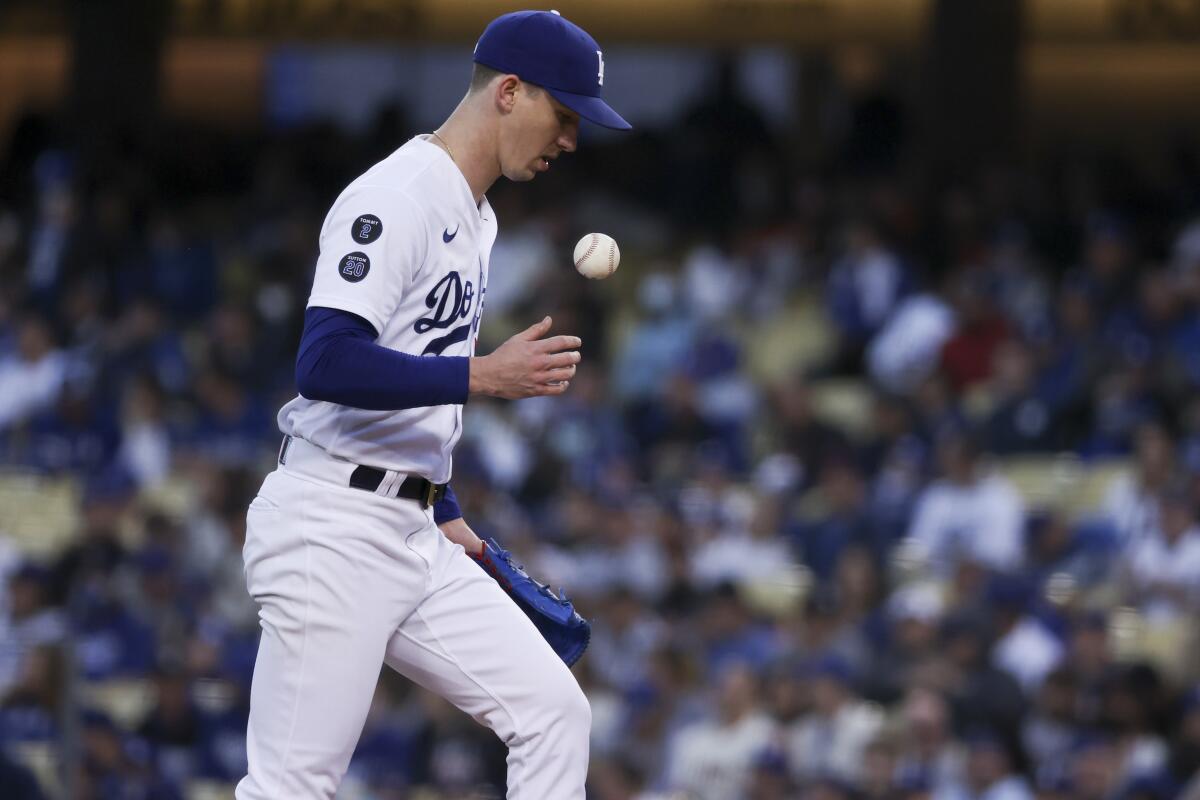
In his first start of the series in Game 1, Buehler threw his fastball almost half the time, a tendency that came back to bite him when Buster Posey and Kris Bryant hit homers off the pitch in a losing, 6⅓-inning, three-run outing.
In Game 4, Buehler opted for a more balanced arsenal.
This time, four-seamers accounted for barely a third of his pitches. Instead, he increased his usage of cutters, a pitch he has steadily improved in recent seasons; curveballs, including several early in counts his second time through the order; and, perhaps most notably, changeups, adding an off-speed element that Giants manager Gabe Kapler acknowledged his team wasn’t fully expecting.
“He mixed in his changeup a little bit more than we would have suspected,” Kapler said. “That was an effective pitch for him.”
The two sides of Giants pitching
As they’ve done all series, the Dodgers feasted against the underbelly of the Giants pitching staff, knocking around their No. 4 starter, Anthony DeSclafani, and one middle relief arm after another.
In the series, Giants pitchers not named Webb, Camilo Doval or Tyler Rogers have combined for a 6.23 ERA, 1.615 WHIP and nearly half as many walks (10) as strikeouts (21).
The problem for the Dodgers: Against the aforementioned trio — all of whom likely will play a key role in Game 5, with Webb starting and Doval, the closer, and Rogers, the submarine right-hander, almost certain to come out of the bullpen — the numbers are concerning.
In a win-or-go-home game Tuesday night, Dodgers right fielder Mookie Betts was again a catalyst in a 7-2 victory over the San Francisco Giants.
In 13⅓ innings against those three, the Dodgers have yet to score. They have just eight hits, have drawn one walk and struck out eight times.
Adjusting to Webb’s groundball-inducing mix of sinkers, sliders and changeups will be particularly important for the Dodgers, who could never get their offense going in Game 1 against the 24-year-old right-hander.
“I think we’re going to go back, talk as a group, come up with a better game plan than we had last time, make some adjustments, and go from there,” Smith said.
Will Smith’s hot bat, cool glove
Smith had two of the most memorable moments during the Dodgers’ World Series run last year, producing an historic five-hit performance in Game 3 of the NLDS against the San Diego Padres and hitting a crucial home run in Game 5 of the NLCS against the Atlanta Braves, helping spark the team’s comeback in that series.
But on the whole, his 2020 postseason finished somewhat underwhelmingly. He batted just .203, spent half the time serving as a designated hitter, and struggled to consistently make smaller contributions to complement his headlines.
This year, his role is different. And so far, so too have been the results.
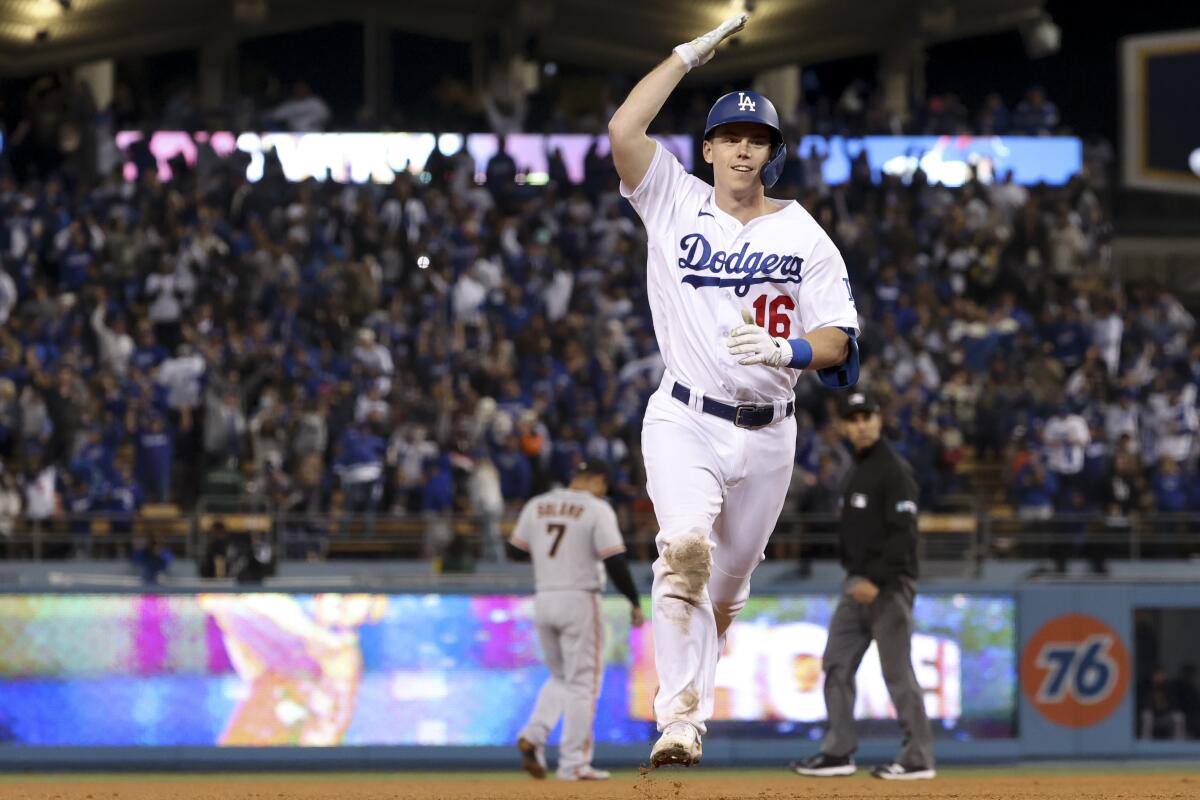
Smith has cemented himself as the Dodgers’ full-time catcher, matching his improved pitch framing from the regular season (he was just above league-average at that skill this year, according to Baseball Savant, after ranking among the worst in baseball last season) with a strong execution of game plans, with Buehler’s Game 4 start serving as the latest example.
More importantly, he has been the Dodgers’ most dangerous batter as well, crushing his second home run of the series in a two-hit performance Thursday after being bumped up into the cleanup spot.
In five postseason games, Smith is batting .333 with three RBIs and an on-base-plus-slugging percentage of 1.206.
Graterol lights up gun
Brusdar Graterol looked amped up for his relief appearance in the sixth inning.
His first pitch exploded out of his hand at 102.5 mph, the hardest he’s ever thrown in the majors and the hardest by any Dodgers pitcher since 2009.
While Graterol topped 100 mph seven times in the inning — including three more pitches that eclipsed 102 mph — the execution was as impressive as the velocity.
At 25, Julio Urías is already six years into his major league career. The longtime prospect has come of age at the right time for the Dodgers.
He got ahead of Posey to induce a leadoff groundout. Then, after Bryant ambushed a first-pitch fastball for a single, Graterol responded by getting Wilmer Flores and Evan Longoria to ground out.
While the 23-year-old right-hander still isn’t racking up many strikeouts, he has been dependable in October. Tuesday was his fourth straight scoreless outing in these playoffs, and the first time he has given up a hit.
“He’s really shown a lot of poise,” Roberts said. “You look at the outings that we’ve run him out there, he’s made good quality pitches and the moment isn’t getting too big for him.”
More to Read
Are you a true-blue fan?
Get our Dodgers Dugout newsletter for insights, news and much more.
You may occasionally receive promotional content from the Los Angeles Times.

